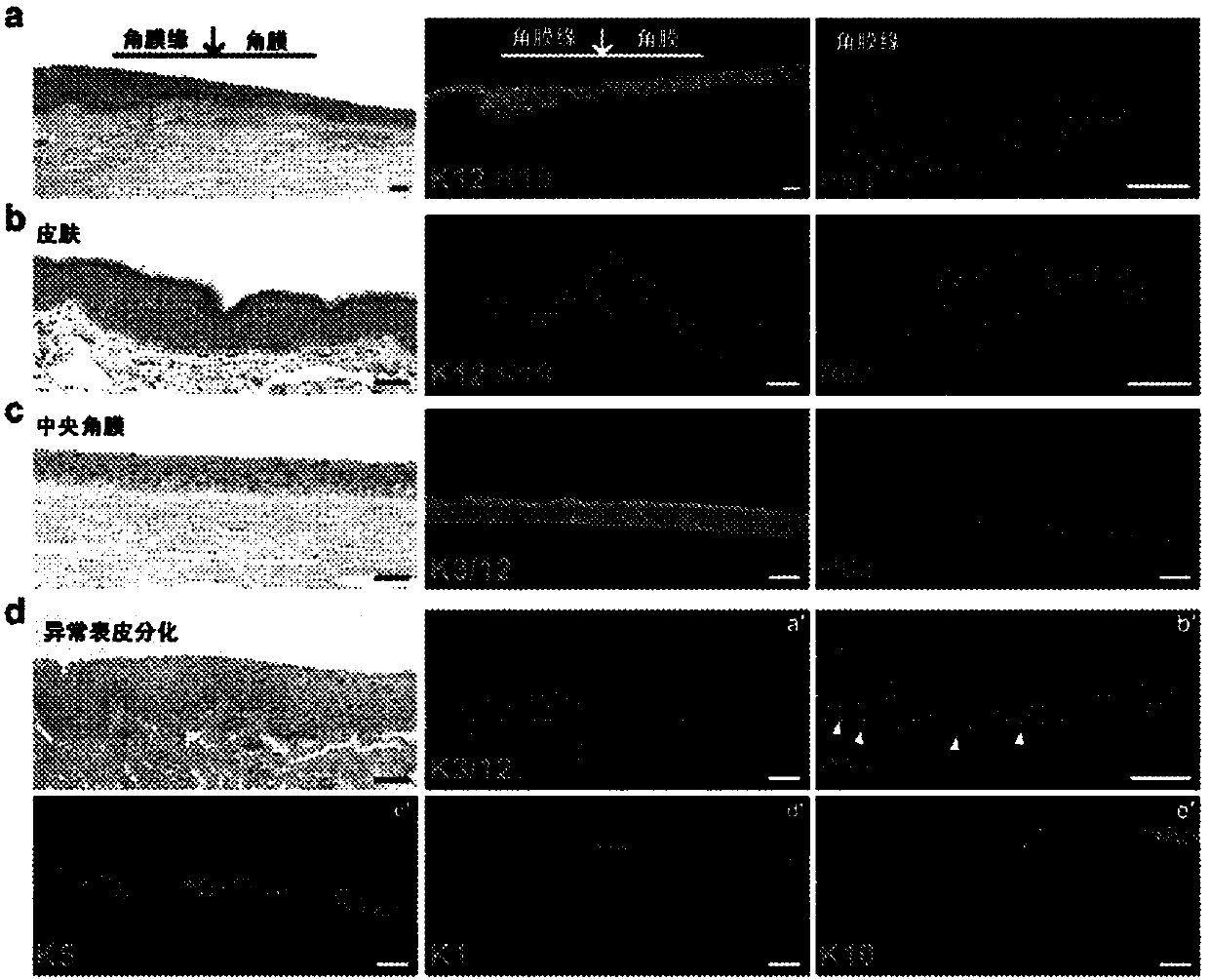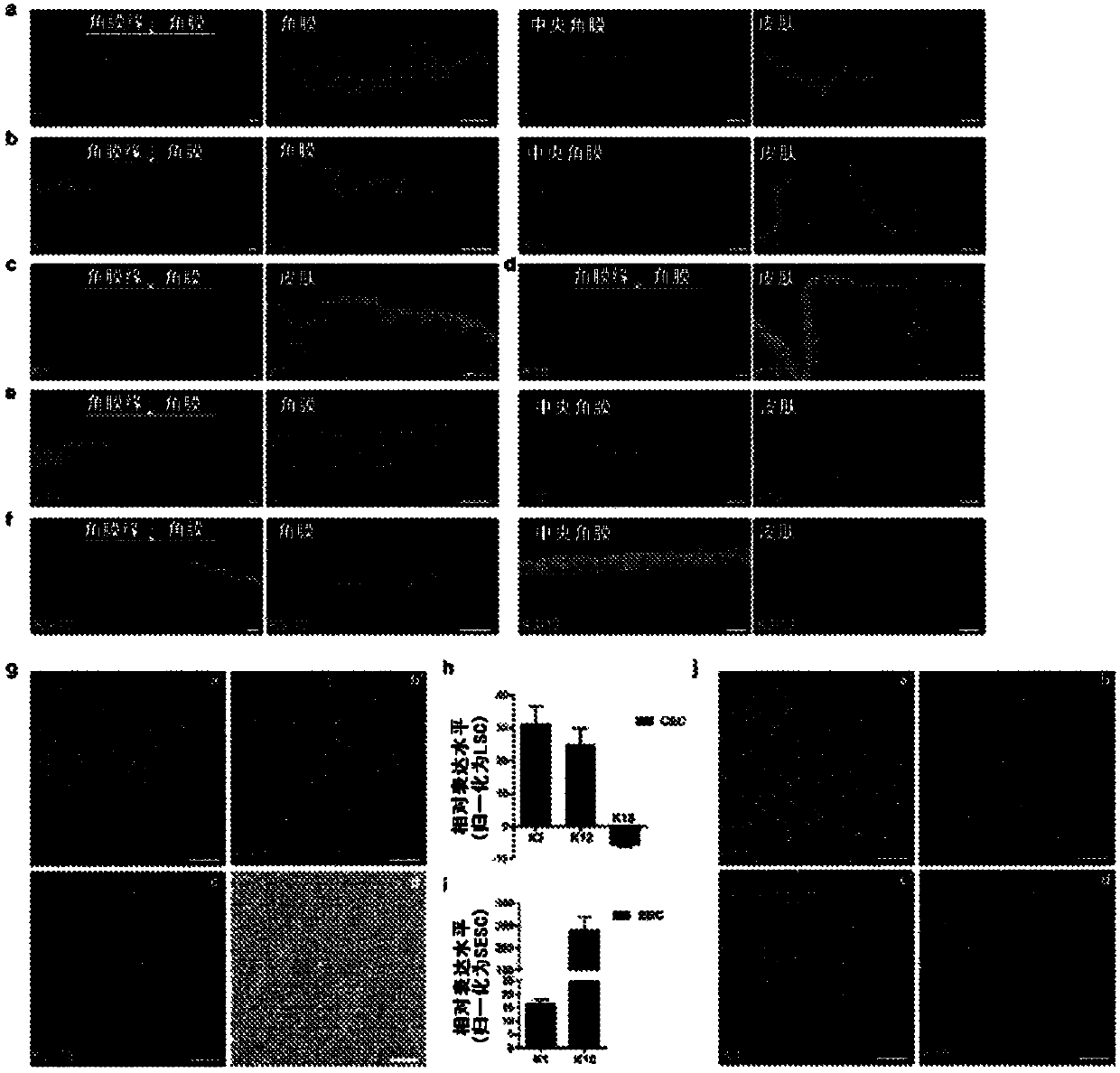Cultured mammalian limbal stem cells, methods for generating the same, and uses thereof
A technology of corneal limbal stem cells and corneal epithelial cells, applied in the field of cultured mammalian limbal stem cells, their production and use, which can solve the problems of limited supply of limbal stem cells, inability to repair the surface of the eye, and improve vision
- Summary
- Abstract
- Description
- Claims
- Application Information
AI Technical Summary
Problems solved by technology
Method used
Image
Examples
Embodiment 1
[0285] Materials and methods
[0286] Human Pathology Samples
[0287] Corneal epithelial squamous metaplasia and all other tissues were obtained as deidentified surgical specimens, fixed in 5% formalin, embedded in paraffin, sectioned and stained for immunofluorescence studies.
[0288] Isolation and Culture of Limbal Stem Cells and Skin Epidermal Stem Cells
[0289]Post mortem human eyeballs were obtained from an eye bank, the marginal region was removed and washed in cold PBS with 100 IU penicillin and 100 μg / ml streptomycin, and cut into small pieces. Cell clusters were obtained by digestion with 0.2% collagenase IV for 2 hours at 37°C and single cells were obtained by further digestion with 0.25% trypsin-EDTA for 15 min at 37°C. Primary cells were seeded on plastic plates coated with 2% growth factor-reduced Matrigel (354230, BD Biosciences). Limbal stem cells from GFP-labeled rats and rabbits were isolated and cultured using the same method as human LSCs.
[0290] Hu...
Embodiment 2
[0357] Materials and methods
[0358] animal
[0359] ROSA mT / mG Mice were previously described (PMID: 17868096;28) and maintained homozygous. P0-3.9-GFPCre mice expressing the EGFP-Cre recombinase fusion protein under the control of the Pax6P0 enhancer were maintained on the FVB background and PCR genotyped as described (29).
[0360] Pedigree Tracing
[0361] By making homozygous GFP reporter mice (ROSA mT / mG ) were crossed with lens-specific Cre transgenic mice (P0-3.9-GFPCre) for lineage tracing experiments, in which Cre expression was under the control of the mouse Pax6 ectodermal enhancer. Eyes were dissected at postnatal (P) day 1 and P60 and fixed overnight in 4% formaldehyde. Tissues were then incubated in 10% sucrose and embedded in optimal cutting temperature medium for cryosectioning. Frozen sections were washed in PBS and imaged on a Zeiss Axio Imager fluorescence microscope.
[0362] Isolation and Culture of Human LSCs and Skin Epidermal Stem Cells (SESCs)...
Embodiment 3
[0423] Method for preparing donor corneal repair material
[0424] 1. Materials
[0425] Limbal Stem Cell Medium or Limbal Stem Cell Maintenance Medium: DMEM / Nutrient Mixture F-12 (DMEM:F-12 with a volume:volume ratio of 3:1) supplemented with: 10% Fetal Bovine Serum , 0.4μg / ml hydrocortisone, 10 -10 μM cholera toxin, 5μg / ml transferrin, 2×10 -9 M 3,3',5-triiodo-L-thyronine, 5 μg / ml insulin, 10 ng / ml epidermal growth factor (EGF), 100 U / ml penicillin, and 100 μg / ml streptomycin. After the 4th cell passage, a ROCK inhibitor was added to the limbal stem cell medium to maintain the LSCs in a proliferative state, such as by adding 1 μM Y-27632. The above components DMEM, F12 medium and fetal bovine serum were purchased from (Life Technologies), the remaining components were purchased from Sigma, USA.
[0426]Limbal stem cell differentiation medium: CnT-30 or equivalent (CellnTec Advanced Cell Systems AG, Bern, Switzerland). Other limbal stem cell differentiation media that ...
PUM
| Property | Measurement | Unit |
|---|---|---|
| transmittivity | aaaaa | aaaaa |
Abstract
Description
Claims
Application Information
 Login to View More
Login to View More - R&D
- Intellectual Property
- Life Sciences
- Materials
- Tech Scout
- Unparalleled Data Quality
- Higher Quality Content
- 60% Fewer Hallucinations
Browse by: Latest US Patents, China's latest patents, Technical Efficacy Thesaurus, Application Domain, Technology Topic, Popular Technical Reports.
© 2025 PatSnap. All rights reserved.Legal|Privacy policy|Modern Slavery Act Transparency Statement|Sitemap|About US| Contact US: help@patsnap.com



